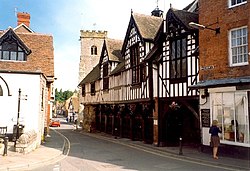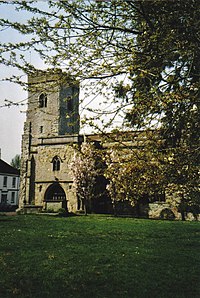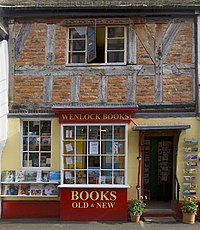Much Wenlock
| Much Wenlock | |
| Shropshire | |
|---|---|
 The Guildhall, Much Wenlock | |
| Location | |
| Grid reference: | SO623997 |
| Location: | 52°35’48"N, 2°33’29"W |
| Data | |
| Population: | 2,605 |
| Post town: | Much Wenlock |
| Postcode: | TF13 |
| Dialling code: | 01952 |
| Local Government | |
| Council: | Shropshire |
| Parliamentary constituency: |
Ludlow |
Much Wenlock, earlier known as Wenlock, is a small town in central Shropshire.
It is found on the A458 road between Shrewsbury and Bridgnorth. Nearby, to the northeast, is the Ironbridge Gorge, and the new town of Telford. The Wenlock Olympian Games set up by Dr William Penny Brookes in 1850 are centred in the town and in venues across Shropshire: Dr Brookes is credited as a founding father of the Modern Olympic Games, as Baron De Coubertin visited the Olympian Games here before creating the modern Olympic Games: the Olympic mascot for London 2012 was named "Wenlock" after the town.
The population of the town's parish, according to the 2001 census, was 2,605.
Notable historic attractions in the town are Wenlock Priory and the Guildhall.
Contents
Name
The word "Much" is added to the town's name to distinguish it from the nearby Little Wenlock, and signifies that it is the larger of the two settlements. Great Wenlock is found as a name too, now obsolete, in some historic sources.
The name "Wenlock" is from Old English, possibly from Wenan loca meaning "Wena's Stronghold", or "Hope stronghold". The town is recorded in the Domesday Book as Wenloch.
History
The town grew around an abbey or monastery founded around 680[1] by Merewalh, a son of King Penda of Mercia. King Penda installed his daughter Milburh ("Milburga") as abbess in 687. Milburga of Wenlock was credited with many miraculous works.[2] The abbey flourished until around 874 when a Danish Viking attack occurred. In the 11th century another religious house was built on the same site by Leofric, Earl of Mercia and Godiva his wife.
In the 12th century, Leofric's minster was replaced by a Cluniac priory, established by Roger de Montgomerie after the Norman Conquest, the ruins of which can still be seen and which is now in the hands of English Heritage. It prospered until the Dissolution of the Monasteries in 1539.
Other architectural attractions include the 16th century Guildhall, many other historic buildings in the Early English style and an annual well dressing at St Milburga's Well on Barrow Street. The town was incorporated under the name of "Bailiff, Burgesses and Commonalty" by King Edward IV in 1468 at the request of Sir John Wenlock, and "in consideration of the laudable services which the men of the town performed in assisting the king to gain possession of the crown." The charter was confirmed in 1547 by Henry VIII and in 1631 by Charles I.
The town is known as the birthplace of Wenlock Olympian Games set up by Dr William Penny Brookes and his Wenlock Olympian Society (WOS) in 1850. In 1861 he was also instrumental in setting up the Shropshire Games and later in 1866, the National Olympian Games. Dr Brookes is credited as a founding father of the Modern Olympic Games. In 1890 it was the turn of the Raven Hotel to be the venue for the annual post Wenlock Olympian Games' dinner, and Baron Pierre de Coubertin was the guest of honour. Copies of some of the WOS's archive images are on display in the hotel, including letters from Coubertin to Brookes. The Wenlock Olympian Games, a nine-day event staged on eight sites across Shropshire, are still held annually during July, and are still organised by WOS. The town's secondary school is named after Dr Brookes.
On 30 May 2012, the Olympic flame of the London 2012 Summer Games, was carried through Much Wenlock to acknowledge the founding footsteps of Dr Brookes. WOS Vice President, John Simpson, carried an Olympic torch from the town into the William Brookes School.
On 7 April 2011 Much Wenlock was announced by Decentralisation Minister Greg Clark as one of the first seventeen communities to test neighbourhood planning, a key feature of the Localism Bill. The Much Wenlock Neighbourhood Plan was launched on 22 November 2011.
Much Wenlock was the location for the third episode of the first series of the archaeology television programme Time Team in 1994.[3]
Churches
Holy Trinity Church, in Wilmore Street, is the Church of England parish church. The first church on this site was built in Anglo-Saxon times but the present church dates from 1150 and was built by the Cluniac monks from Wenlock Priory. Features of interest include the plain Norman tower]] which had a spire until early in the twentieth century, and a memorial inside the church to W P Brookes as well as the refurbished family gravestones in the churchyard. The churchyard is a large, open, green space with some tall trees.
There is also a Methodist church in King Street.
Cultural associations
- The annual Wenlock Olympian Live Arts Festival is held during March as part of Wenlock Olympian Games. There are competitions in music, creative writing and dance.
- Nearby is Wenlock Edge, an important hill feature. Both the Edge and the town are the subject of several poems by A E Housman in his famous volume A Shropshire Lad, such as: "On Wenlock Edge the wood's in trouble..." and "Tis time, I think, by Wenlock town...". In 1909 these poems were set to music by Vaughan Williams as On Wenlock Edge, Song cycle for tenor and piano quintet.
- The Victorian era romantic painter and sculptor Robert Bateman (1842–1922) lived near Much Wenlock, at the 16th century Benthall Hall. In 1907 Walter Crane described his painting as of... "a magic world of romance and pictured poetry ... a twilight world of dark mysterious woodlands, haunted streams, meads of deep green starred with burning flowers, veiled in a dim and mystic light."
- The novelist Mary Webb (then Mary Meredith), lived in childhood at The Grange just outside the town, on the Church Stretton road, from 1882 to 1896.[4]
- St Milburga's Well was supposed in the Middle Ages to cure eye diseases and the town was a destination popular for mediæval pilgrims, coming to worship at St Milburga's Shrine.
- The London 2012 Summer Olympics mascot, Wenlock, is named after the town in honour of Dr WP Brookes and his Wenlock Olympian Society.
- Much Wenlock is host to an annual Poetry Festival, held the week-end after Easter. Founded by Anna Dreda of Wenlock Books, its patron is Carol Ann Duffy.
- The actress Rosemary Leach was born here.
- The actress Gabrielle Drake lives here.
On film
- In 1950 the town and its surrounding countryside were the locations of the film Gone to Earth by Powell and Pressburger. In 1985 the film was fully restored by the National Film Archive, and premiered to great acclaim. The New Statesman review claimed the restored film to be... "One of the great British regional films ...(and)... one of the most beautiful films ever to be shot of the English countryside". The film was based on the 1917 novel of the same name by Mary Webb, which was partly inspired by the Diary of Francis Kilvert.
- The John Cleese film Clockwise was filmed partly in and around Much Wenlock.
- Parts of the film "European Psycho" were filmed here, with the Guildhall being used as a nightclub.
In July 2011, the documentary 'Tony Robinson's Olympics' was filmed during the Wenlock Olympian Games and also in and around Much Wenlock
Books
- The fiction based on fact novel 'A Spurious Brood' is set in and around Much Wenlock. The book is based on the true story of Katherine More, youngest daughter of an ancient Shropshire family, whose four children were taken from her to be transported to America on board the Pilgrim Fathers' ship the Mayflower.
See also
Outside links
| ("Wikimedia Commons" has material about Much Wenlock) |
- Much Wenlock Town Council
- Shropshire Tourism - A tourism website for Shropshire
- Ironbridge Tourism - A tourism website for Ironbridge
- Wenlock Olympian Society
- London 2012 torch relay bearers for Much Wenlock
- Much Wenlock Visitor Guide by Virtual Shropshire
- A Literary Walk
- Festival at the Edge, an annual three-day festival of traditional storytelling
- William Brookes School and Sixth Form
- Aerial photographs of Much Wenlock
- Much Wenlock Forester Charitable Trust
References
- ↑ Finberg, Early Charters of the West Midlands, 209, dates the earliest charter in the Testament as 675 × 90.
- ↑ See H P R Finberg, Early Charters of the West Midlands (1961), 197–216; A. J. M. Edwards, 'An early 12th century account of St Milburga of Much Wenlock', T.S.A.S. lvii. 134–42
- ↑ Time Team - the full programme list at Channel4.com
- ↑ Dickins, Gordon (1987). An Illustrated Literary Guide to Shropshire. Shropshire Libraries. pp. 74, 104. ISBN 0-903802-37-6.

